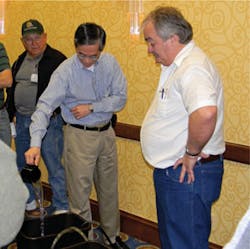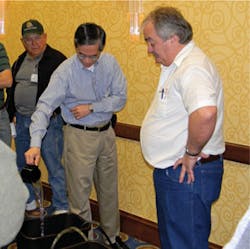“I have been in industry for 37 years, and I have seen much of what Larry talked about. Now I know how to start correcting problems I have seen. Wish I had been in this class 30 years ago.”
The above quote is just one of many outstanding comments we received from the attendees at last month’s Pump Guy Seminar in Houston. And it continues to amaze me just how well this training resonates with folks across the United States, who come from such a wide variety of professional and industry backgrounds.
For example, in Houston, Larry Bachus (a.k.a. “Pump Guy”) kicked off the 2011 Pump Guy Seminar Series with a three-day training to an audience that included engineers, mechanics, reliability, research, maintenance, product management, and even a college professor. Industries represented at the seminar included food and beverage, chemical, oil & gas, equipment manufacturers, water & wastewater, and construction. It was an eclectic bunch for sure, but the Pump Guy’s message kept everybody engaged for three full days of lectures.
One of the take-home messages of the training was the need for pressure gauges on the inlet and outlet of the pump. “Maintenance’s best efforts are being sabotaged by people who don’t even know they’re sabotaging maintenance,” bellowed the Pump Guy on Day Three of the Houston training, driving home a point he made consistently throughout his presentation – i.e., if the pump doesn’t have gauges located directly before and after the suction and discharge of the pump, then there is no way to know if the pump is operating at its best efficiency point (BEP) and, thus, it’s impossible to know the true cause of persistent pump maintenance.
“Pumps are slightly more complicated than a butter knife,” said Bachus. However, he said, most pump users are burning through mechanical seals and bearings on a regular basis.
“We’re just not applying what we learned in school – keep the system balanced,” he said. “If I insert a temperature probe in a line with short-radius elbows in front and behind, you may increase the resistance in the system by a foot,” said Bachus. “We need to rebalance the system to ease that resistance. What could we do?” he asked. “We could replace the short-radius elbows with long-radius elbows to re-balance the systems,” said Bachus. “Everybody knows that, right? And all engineers rebalance the system when they add something to the line, don’t they?” – a question to which the attendees responded with a chuckle.
For an exclusive video clip of last month’s Pump Guy Seminar in Houston, check out the Flow Control Facebook page at Facebook.com/FlowControlMagazine. The next Pump Guy Seminar will be in Los Angeles for May 16-18 training. For more details and to register for this event, visit FlowControlNetwork.com/events.asp.
Jim Lauria Joins the Flow Control Editorial Advisory Board
Jim Lauria, vice president of Marketing & Business Development for Amiad Filtration Systems (amiad.com), an Israeli manufacturer of clean technology water filtration systems, has been added to the Flow Control Editorial Advisory Board. Jim earned a bachelor’s degree in Chemical Engineering from Manhattan College and has more than 20 years of global experience as a business executive in the water treatment industry.
Jim is an active member of the American Water Works Association and the American Membrane Technology Association. You can read Jim’s blog on water issues at huffingtonpost.com/jim-lauria. We look forward to leveraging his expertise to improve Flow Control’s editorial offerings going forward.
– Matt Migliore, Editor-in-Chief
[email protected]



